Solar wiring, chase through to roof?
Printed From: R-pod Owners Forum
Category: R-pod Discussion Forums
Forum Name: Podmods, Maintenance, Tips and Tricks
Forum Discription: Ask maintenance questions, share your podmods (modifications) and helpful tips
URL: http://www.rpod-owners.com/forum_posts.asp?TID=13040
Printed Date: 16 Aug 2025 at 4:13pm
Software Version: Web Wiz Forums 9.64 - http://www.webwizforums.com
Topic: Solar wiring, chase through to roof?
Posted By: Motor7
Subject: Solar wiring, chase through to roof?
Date Posted: 16 Jul 2019 at 11:53am
|
How/where did you roof solar folks get the wiring up to the panels?
On my motorhome I used the refer vent, but my pod vents through the side. Looking at following the a/c wiring now, but I think they Staples or secured those wires since I'm not finding any slack in them. Any help is appreciated. ------------- 2016 R-Pod 176T |
Replies:
Posted By: Motor7
Date Posted: 16 Jul 2019 at 4:48pm
Looking at the entry wall to the left of door:
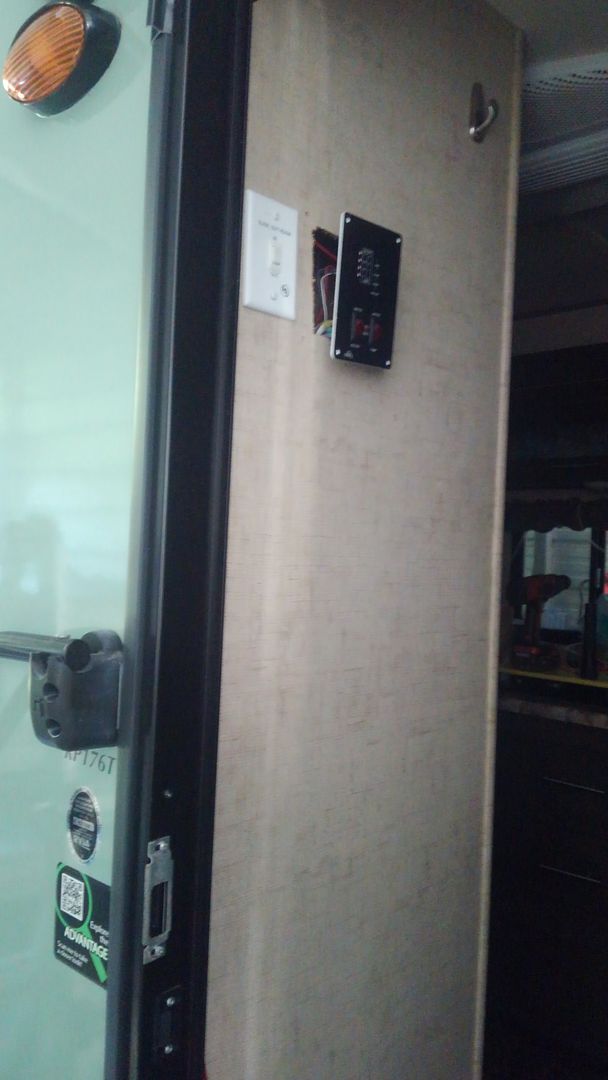
After crawling around under the pod I found that the entry wall is hollow from floor to ceiling. The tank monitor, hot water heater switch and a light switch are all on it. I can see where the wires go in under the floor by the frame, and by removing the tank monitor I see the A/c unit wires in there too. Drilling a hole through the roof into that chase should let me fish the wire down it.....maybe. ------------- 2016 R-Pod 176T |
Posted By: Motor7
Date Posted: 16 Jul 2019 at 4:55pm
|
Also, I have a Renogy 160 Watt flex solar panel enoute( on sale on the 'zon for $223). And am considering Eternabond to stick it to the roof without drilling any holes.
------------- 2016 R-Pod 176T |
Posted By: offgrid
Date Posted: 17 Jul 2019 at 5:08am
|
I don't know the 176T layout details but I would suggest placing a dual gland cable roof entry plate above any convenient cabinet and running the solar connections down a back inside corner of the cabinet from there. In the 179 we can run the wires down through the enclosed cabinet where the stereo is so they aren't visible, but for me even if I didn't have that option as long as they're inside the back of a cabinet that would be good enough. Trying to pull them through the small mostly foam filled wall cavity seems like too much effort for too little benefit. Just an opinion. ------------- 1994 Chinook Concourse 1995 RV6A Experimental Aircraft 2015 Rpod 179 - sold |
Posted By: Motor7
Date Posted: 17 Jul 2019 at 10:13am
|
OG, I looked inside the stereo/tv/speaker cabinet and there is plenty of room in there except that it terminates on the front curved wall. If I exit the roof there, it will be too far forward on the nose and visible.
Are your interior walls foam filled? Mine seem to all be hollow. The one in the picture is built as a double wall with a large chase cavity inside. I considered a portable panel and might still add one later. For now I want a permanent roof mount . Many boondocking places Out west have little or no tree cover. ------------- 2016 R-Pod 176T |
Posted By: offgrid
Date Posted: 17 Jul 2019 at 10:31am
|
In the 179 the stereo is under the flat roof section so I don't have that problem. But there must be a cabinet under the flat roof section somewhere you can use? If the wires are run along an inside back cabinet corner then they're not going to be obtrusive, you can also conceal them with some wire mold or wire loom if it bothers you. The walls are supposed to be filled with rigid foam. Take a look at the construction video: https://www.youtube.com/watch?v=vMXneKc_fDo - https://www.youtube.com/watch?v=vMXneKc_fDo ------------- 1994 Chinook Concourse 1995 RV6A Experimental Aircraft 2015 Rpod 179 - sold |
Posted By: Motor7
Date Posted: 18 Jul 2019 at 5:52am
|
Cool video, I had not seen that one. They really don't mention interior walls, and at least in my 176, they are un-insulated. Getting new Endurance tires put on today, solar panel and marine grade tinned copper 10 ga wire arrive tomorrow, so I will update soon on the chase situation. I will use a mirror an light to see down into that wall to make absolutely sure I can go from floor to ceiling without any obstruction. Kinda makes me want one of those HF inspection cameras now......sure would come in handy. I did think about pulling the factory solar wiring out and re-routing it, but decided just to stretch new better quality wire from battery's to panel. The stuff the factory uses is not sheathed or tinned and is pretty stiff stuff. 25' of Anchor marine grade duplex was only $36 shipped. I plan on mounting the surface mount Renogy 20 amp charge controller high up on that entry wall if all goes according to plan. ------------- 2016 R-Pod 176T |
Posted By: offgrid
Date Posted: 18 Jul 2019 at 6:50am
|
Yeah, the interior walls are uninsulated. I thought you were talking about using an exterior wall. if you can get a fish tape up through an interior wall to the roof then you should be able to pull the solar conductors down no problem. You didn't mention it but if you haven't already planned for it, please do add an appropriately sized fuse at the + battery connection to your solar system. FR's unfused conductors leading to the Zamp outlet on my 179 were a hazard, any + conductors originating at the battery should be fused for safety. For 10awg wire you can use up to 30A. ------------- 1994 Chinook Concourse 1995 RV6A Experimental Aircraft 2015 Rpod 179 - sold |
Posted By: Motor7
Date Posted: 20 Jul 2019 at 6:58am
Wire arrived first, so I started measuring and drilling.
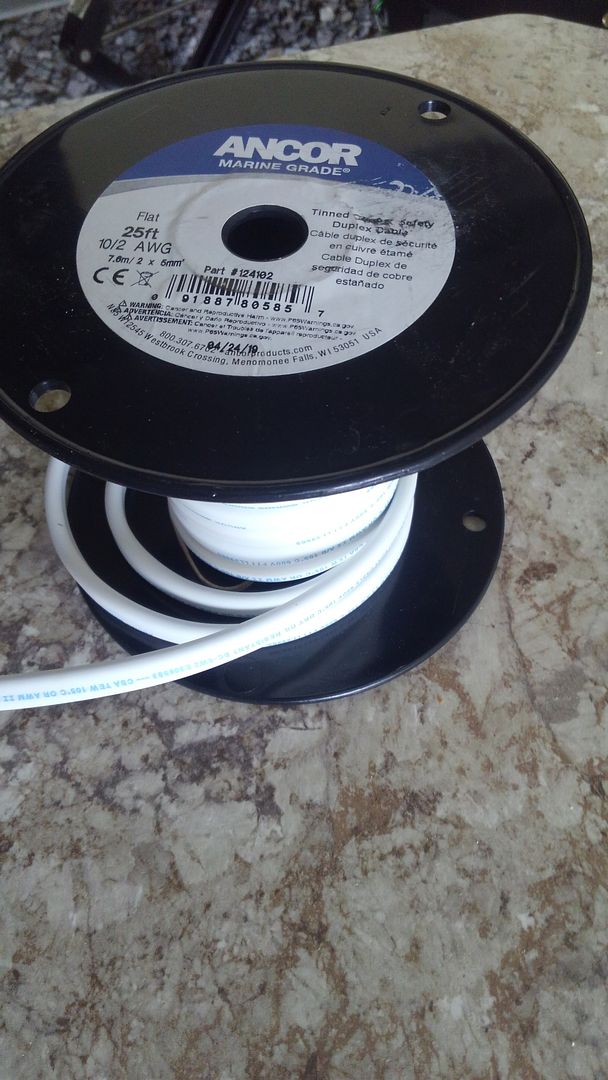
The wiring for the tv antenna and the black tank vent are in this wall, so I drilled my hole between them. 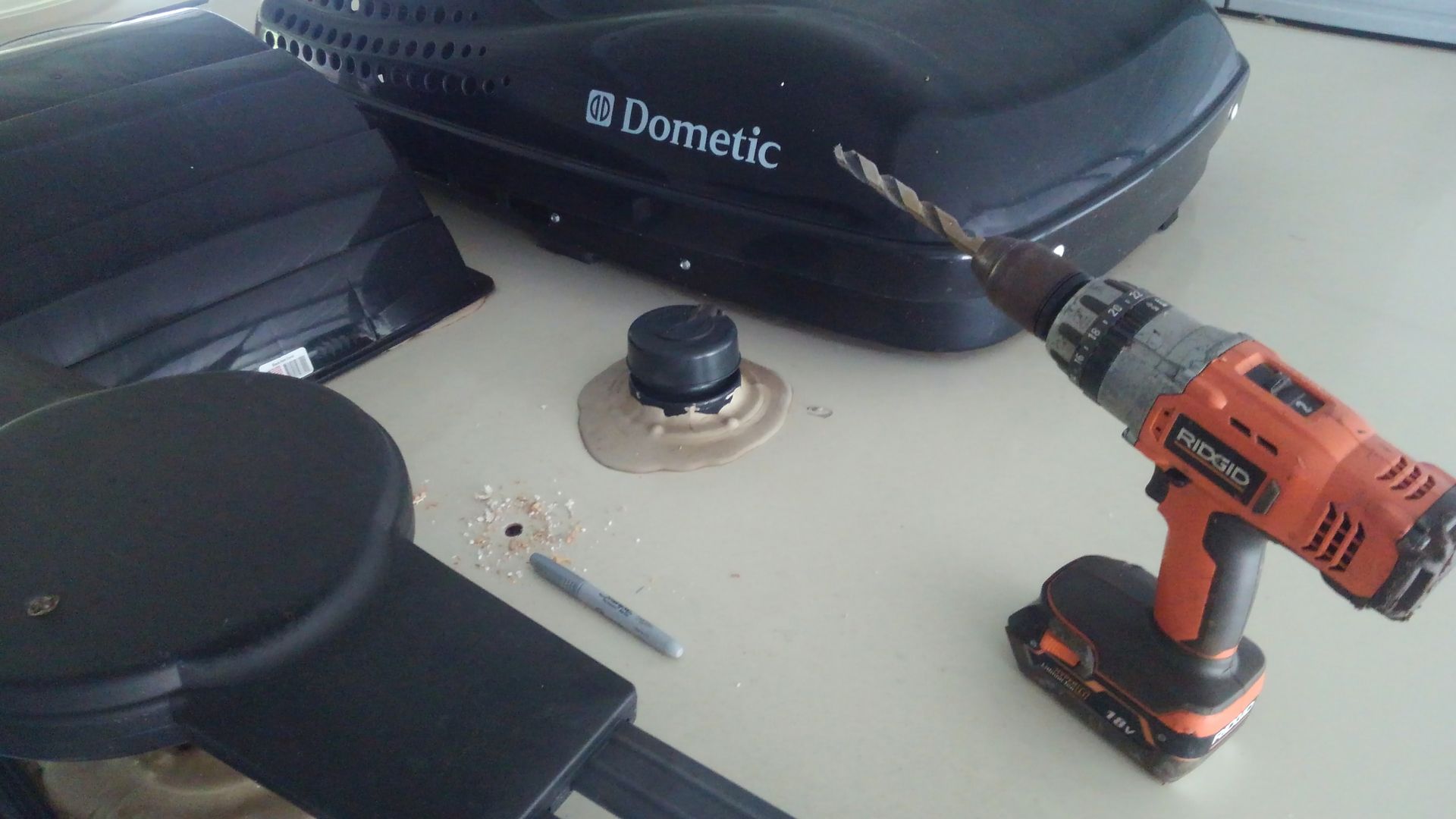
I looked at the location where all the factory wires went in here (far right), but that did not lead inside the wall but into the area under the head. Directly under the center of wall is where I drilled and you can see the heavy wire I used for a fish: 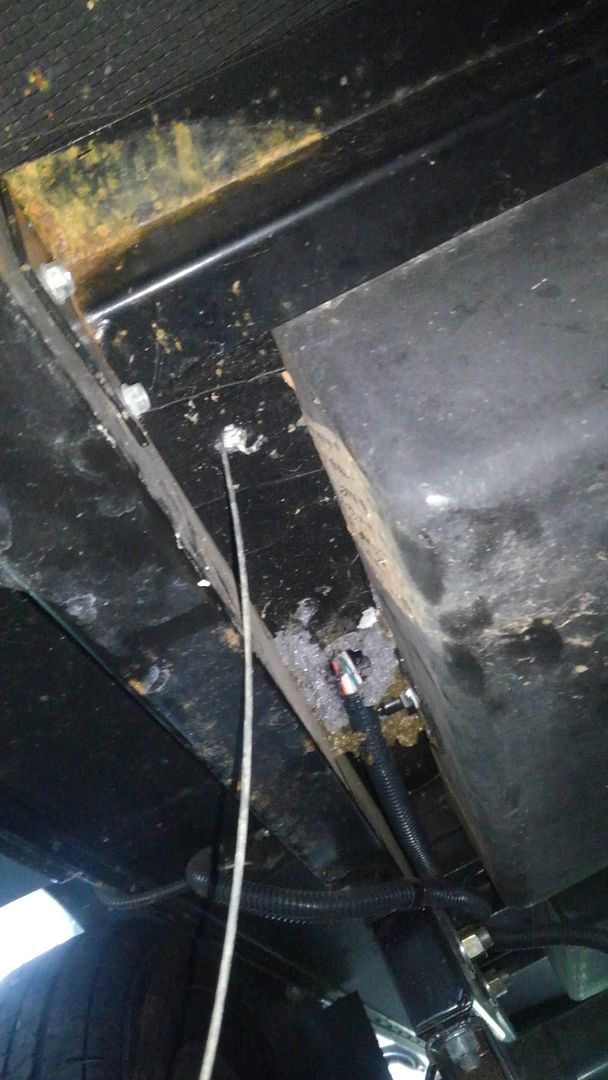 ------------- 2016 R-Pod 176T |
Posted By: Motor7
Date Posted: 20 Jul 2019 at 7:14am
I dropped the wire down from the roof and the fish up from under the floor. Using that opening for tank monitor on the wall i was abke to grab both and tape the wire to the fish. This allowed me to pull the wire through and forward along the frame to the battery box.
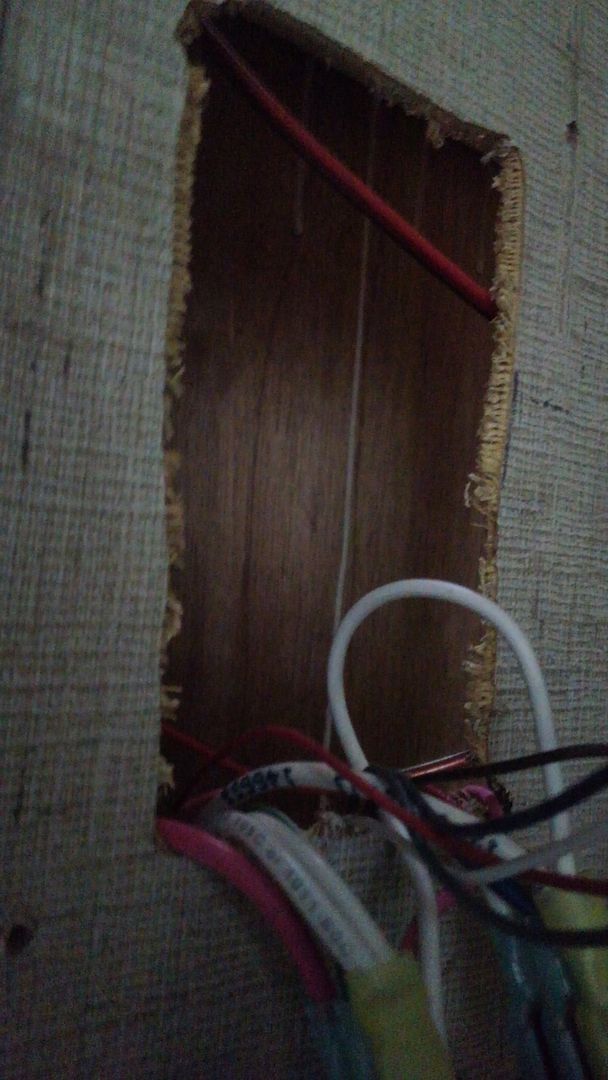
Brown Santa then dropped off the 160 watt flexible solar panel. Unfortunately, the only place to mount it is to the front and partially on the radius. It's also going to be subject to some partial shading from the antenna and the a/c, but it can't be helped: 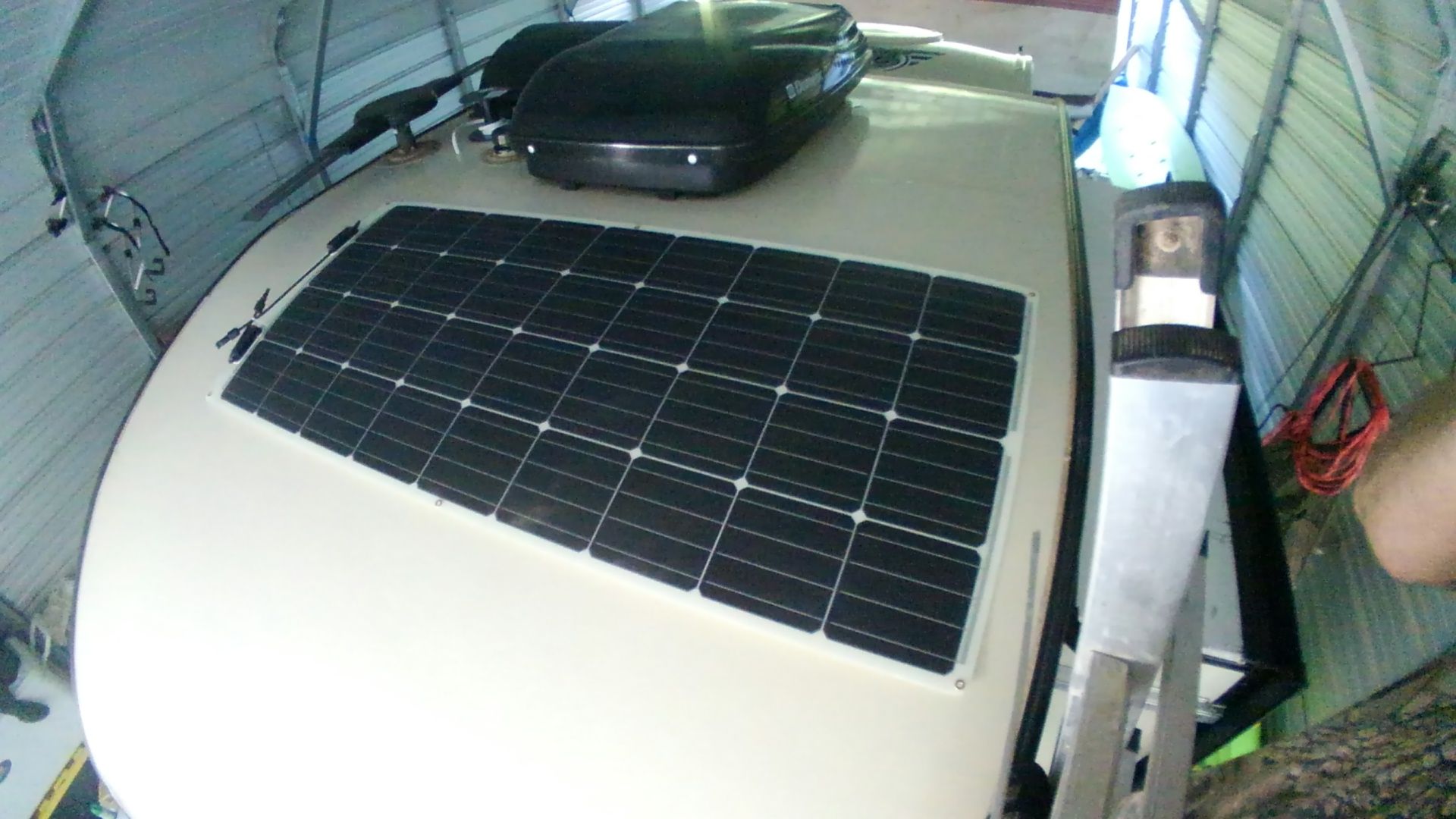 ------------- 2016 R-Pod 176T |
Posted By: Motor7
Date Posted: 20 Jul 2019 at 7:22am
|
There are 6 grommet holes on the solar panel. I'm going to caulk a line of Eternabond on the leading edge and the two ends, then screw it down using a stainless fender washer and stainless screw through each grommet. I will also pre-drill each hole to prevent the fiberglass from cracking/ splintering. I am not going to caulk the whole perimeter of the panel because I want any water trapped under it to escape.
I decided to screw and glue the panel down after reading several accounts of those only glued or taped flying off on the highway in high winds. ------------- 2016 R-Pod 176T |
Posted By: offgrid
Date Posted: 20 Jul 2019 at 8:08am
|
I used to design and perform reliability testing on solar modules. I'm not a fan of "flexible" solar modules because they really aren't. The cells are silicon crystal which is of course a brittle rigid material. If you're interested in my other concerns with this type of product I posted on it last year, so I won't repeat those here. All I'll suggest here is that if there is any other place where you can mount the module that is on a flat roof surface you'll be better off as that will keep the cells from being under continuous bending stress. Just a friendly suggestion, not trying to start an argument  ------------- 1994 Chinook Concourse 1995 RV6A Experimental Aircraft 2015 Rpod 179 - sold |
Posted By: Motor7
Date Posted: 20 Jul 2019 at 8:49am
|
OG, I hear ya and I agree. But, for aerodynamics and weight reduction I wanted to try one. As for a flat surface, here isn't one except between the a/c and the sidewall which is about 25 inches wide and the panel is 26.5" wide. The roof space on the 176T is very limited, so I'm just going to have to go with what I have. Leaving for Manitoba next week and the 'pod will be in a field at a classic rock fest for over a week with no hookups. I just want to keep my 2 6v's topped off and run a 12v fan on me at night. When I get back I will find a spot on the backside of the roof for a smaller panel, maybe a 100 watt. Also, my pod lives in an enclosed shed when not on the road, so the panel(s) will not be getting beat up by the weather/sun 365. ------------- 2016 R-Pod 176T |
Posted By: offgrid
Date Posted: 20 Jul 2019 at 9:28am
|
Roger that. its not like it won't work, its more a matter of longevity. Since you're now planning to use fasteners, you might want to minimize the adhesive to make it easier to replace down the road if need be. The 179 has a big space behind the a/c, I plan on using that for a 350-ish watt module. ------------- 1994 Chinook Concourse 1995 RV6A Experimental Aircraft 2015 Rpod 179 - sold |
Posted By: podwerkz
Date Posted: 20 Jul 2019 at 10:10am
|
You might want to insert a sheet of coro-plast under the panel. It should help with the heat build-up. Also, I found that on my r-pod, the trim strips that run from side to side on the ceiling, inside the trailer, are also 'covers' for the open C-channel aluminum frame. Double check yours of course, but that will give you an idea about where you can drill. On mine, there is 12v wiring inside those channels. By the way, the rock festival sounds cool....gotta link for that? ------------- r・pod 171 gone but not forgotten! |
Posted By: offgrid
Date Posted: 20 Jul 2019 at 12:32pm
That will help reduce the temperature of the fiberglass roof by adding insulation between the heat source (the sunlight on the solar module) and the roof. Under full sun on a windless day a direct mount solar module can run around 70-80 degrees above ambient temp, that's pretty darn hot. But it won't help the module itself run any cooler, the airflow through the tiny little holes in the coro-plast is pretty minimal. Now, if you worked up a way to flow water through the holes in the coro-plast (or used say EPDM rubber solar pool heater tubing under the module) that would cool the module effectively and provide hot water as well. Roughly speaking the 6 gal water tank would pick up about 20-25 degrees an hour under full sun conditions from a 160 watt size module. An RV mounted PV/Thermal solar system, sounds like a fun project  ------------- 1994 Chinook Concourse 1995 RV6A Experimental Aircraft 2015 Rpod 179 - sold |
Posted By: Motor7
Date Posted: 20 Jul 2019 at 12:43pm
|
Podwerkz, here ya go: https://rockinthefields.ca/ - https://rockinthefields.ca/ Here is the long explanation  : :My wife is from Minnedosa & we have a house there. The first festival there was something like 25 years ago and called RockFest. They had some heavy hitters on stage, Billy Idol, Alice Cooper, Boston, Def Leppard, Jerry Lee Lewis, Pat Benitar, Joan Jet, Sammy Hagar, and many more. The site on Lake Minnedosa grew to a crowd of 20,000 over the years, and things kinda got out of control. Then the management got greedy, bands didn't get paid and the whole thing collapsed. Around 10 years ago a committee of volunteers re-organized the defunct festival and named it "Rock In The Fields" and it's all non-profit. It has slowly grown to a crowd of around 5,000 which is as big as they want it to get. My wife and I volunteer at the site along with friends and family. In return we get free entrance passes and a place to camp. I help with the set up and break down of the site, so we arrive almost a week ahead the kick-off. We have three stages up and running each day, so it's never a dull moment. ------------- 2016 R-Pod 176T |
Posted By: podwerkz
Date Posted: 20 Jul 2019 at 1:18pm
Yes, the main benefit is for reduced heat transmission into the roof. That's the reason for doing it. But, expansion and contraction of the panel itself is also mitigated somewhat with the coroplast, and there should be less stress on the adhesives (or fasteners) and the underlying roof structure. All you have to do it lay a flat palm on a flexible panel in full sun on a hot day...trust me on this...it wont take you very long to pull your hand away!
------------- r・pod 171 gone but not forgotten! |
Posted By: podwerkz
Date Posted: 20 Jul 2019 at 2:43pm
|
Motor....dang that looks like a really great time up there! Too bad they didn't have their people contact my people...it's in early August, and in conflict with Sturgis! https://www.sturgismotorcyclerally.com/concerts/ - https://www.sturgismotorcyclerally.com/concerts/ Oh well... maybe next year! {edit: Woodstock 50 appears to be circling the drain....a lousy lineup of bands, conflicting schedules with Sturgis, and legal and financial issues means it may not happen} Have you heard of MusicFest at Steamboat Springs, Colorado? The bands aren't posted yet but it always a great lineup of Texas country, rock and roll, etc. http://themusicfest.com/home/ - http://themusicfest.com/home/ This one is on my bucket list also....but I'm NOT a snow-skier so I will just have to sit in the lodge, drink hot toddies and watch the cute snow bunnies... Which would not be all bad.  ------------- r・pod 171 gone but not forgotten! |
Posted By: offgrid
Date Posted: 20 Jul 2019 at 2:52pm
I did some of my early work on solar module performance in Phoenix, where I regularly saw module temps approaching 100C/212F. At that point not only do you really want to avoid touching them but you'll be significantly degrading the lifetime of the plastics in the solar module and, worse, in your rPod roof. The electrical performance will drop by about 30% as well. ------------- 1994 Chinook Concourse 1995 RV6A Experimental Aircraft 2015 Rpod 179 - sold |
Posted By: podwerkz
Date Posted: 20 Jul 2019 at 3:02pm
|
Yep, I consider flexible panels as disposable...my experience and other's experience, back this up. I have one that failed a couple of years ago, after less than 2 years of intermittent use, and I have begun to slice it up to see if I can use a few of the individual cells in a small project un-related to camping or RVing. The thin conductors between cells are a bit of a puzzle...but I'll figure it out. At any rate, the life and health of the flexible panel is quite secondary, in my opinion, to the life and integrity of the r-pod roof and the foam underneath the outer skin...so I would gladly let the panel destroy itself in thermal run-away to save the r-pod roof, if it came to that. The only panel I have secured to my r-pod roof is a small 50w rigid glass panel with an air-gap under it. Otherwise I have portable and truck-mounted rigid glass panels that should last for many years, without damaging anything or self-destructing.
------------- r・pod 171 gone but not forgotten! |
Posted By: Motor7
Date Posted: 20 Jul 2019 at 3:15pm
|
That's odd, in all my research on the flex panels I never ran across anything about excessive heat. It's too late now since I installed the panel right on the roof yesterday evening. I have an ir thermometer, so I Wil do some spot checking on those temps.
I have not been to Steamboats gig, but we have skied there. ------------- 2016 R-Pod 176T |
Posted By: offgrid
Date Posted: 20 Jul 2019 at 3:52pm
Oh yeah, that's one of the biggest issues with them: cell breakage, overheating, cupping, scratching, dirt adhesion. Those are the main issues in what I think are probably the order of importance. Add hail damage toward the top of the list if you live or camp in a place that gets serious hail. I did a post on this back around the beginning of the year, and there's lots of comments on it on the internet. To see what you have temp wise, measure with the suns rays falling perpendicular to the solar module surface, cloudless sky, no or slight wind at most, wait for at least 60 minutes of sun exposure to get things stabilized. You don't really need to do the measurement on a hot day, just measure the difference between the module and ambient temp. You should see something like 100F plus above ambient temp. That will track whatever ambient temp you see later. In the east you're not likely going to see 200F module temps, you have to go to the western deserts to get that. Assuming you're charging, check out several solar cells, the temp will probably vary slightly from one to the next due to electrical variations, and if you find one that's broken the unbroken part will be hotter than the rest. If you're careful measuring you can even see the temp difference when the module is charging compared to when its not. If you connect the module the temp goes down around 10F because some of the solar energy is being converted to electricity so doesn't show up as heat. There is no other electrical device that when you turn it on the temp drops (a fridge doesn't count because the condenser coil heats up when you turn it on). ------------- 1994 Chinook Concourse 1995 RV6A Experimental Aircraft 2015 Rpod 179 - sold |
Posted By: offgrid
Date Posted: 20 Jul 2019 at 4:05pm
The cell interconnect tabs run from the front of one cell to the back of the next, which is what creates the series string of cells. Depending on what you have they are usually solder coated copper ribbon. Google "solar cell tabbing ribbon", it is available on ebay if you want more. The tabs can be a real PITA to work with especially on the cell fronts because they are machine soldered to the cell metallization layer, which is very thin. Try removing the tabs from the backs of the cells rather than the fronts, there is more metallization on the cell backs to re-solder to. There should be visible spots where the tabbing machine attached the ribbons to the cells, if you place your soldering iron on those spots while gently pulling the tabs they should come off, one spot at a time. ------------- 1994 Chinook Concourse 1995 RV6A Experimental Aircraft 2015 Rpod 179 - sold |
Posted By: podwerkz
Date Posted: 20 Jul 2019 at 5:21pm
|
lol....wishful thinking. The cells are imbedded in the PET or ETFE or XYZ or whatever the plastic polymer is. Do you remember when we were kids and you would see those clear acrylic paper weights with a scorpion embedded inside? Imagine trying to extract that scorpion without damaging it. Chisels, dremels, utility knives, micro torches, scrapers, nippers, cutters, surgical tweezers, files etc.......I have all kinds of tools available but my eyes and hands just dont work like they did when I was 25 years old. I managed to uncover some of the copper and do some voltage tests in full sunlight but the results are inconclusive...so far. And, there seems to be a parallel pair and a series pair of ribbon conductors sandwiched on each edge of each cell. A total of 8 connections PER CELL. Who knew? Or possibly some of those ribbons are embedded between the cell and the polymer with no electrical connection....its really hard to tell, and you cant see it without an x-ray machine....and mine is, wouldn't you know, at the repair shop.  The conductors are so thin they get mangled when I get close to them with any of the tools I've tried...maybe some kind of solvent that would dissolve the plastic but leave the copper, silver, and silicon un touched...of course, whatever that gallon of miracle chemical costs I could simply buy whatever small cells I want from the ebay store. No, these were designed to stay put. But....the panel is junk anyway, so I'm having fun with it. Learning is a lifelong passion for me. ------------- r・pod 171 gone but not forgotten! |
Posted By: offgrid
Date Posted: 21 Jul 2019 at 5:18am
|
Ha Ha you must be a glutton for punishment as they say.... I assumed from your description that you had a delaminated module to begin with or you wouldn't be trying to do what you're trying to do. That's not uncommon for many poorly made products, some of them look ok at first but just peel right apart. ETFE (Tefzel) is the front superstrate material in most "flexible" modules. The encapsulant is usually EVA (ethylene vinyl acetate) in any module. In the layup there is the superstrate, an EVA sheet, the cell circuit, another EVA sheet, then the backsheet, usually PVF (Tedlar). The layup is placed in a laminator which de-airs the assembly, then cures the EVA under heat and pressure. Once heated properly long enough the EVA becomes highly cross linked so a really tough material. IOW, you're not getting that module apart without destroying the cells. If you want to try anything at all try a heat gun. If the module wasn't properly laminated and the EVA cross linked to begin with it remains soft and flexible and will peel off. It will drip and burn though if you get it hot enough. There won't be both series and parallel connections between the same cells, that would just short them out, so I'm curious what module you're working on. Some module designs use separate conductors concealed behind the cells to return the cell row output back to one end of the module, but usually there is a bus bar that connects one row to the next which is reversed so the series string can just continue on back and forth along the module. They're not Sunpower cells with all the contracts on the back are they? If you want to make your own custom modules buy a stack of cells and some interconnect ribbon and bus bar material. Its really pretty cheap nowadays. That part is pretty straightforward DIY, fun to come up with a design that fits where you want it to go. and has the voltage you want. You just need a good soldering station and some jigs and fixtures. Its the encapsulation that's hard to do in your garage, unless you want to build a laminator, you'd need a vacuum pump and bag and silicone heating blanket. Or you could go for poured urethane. None of this will save any money over just buying off the shelf of course.
------------- 1994 Chinook Concourse 1995 RV6A Experimental Aircraft 2015 Rpod 179 - sold |
Posted By: podwerkz
Date Posted: 21 Jul 2019 at 11:38am
|
Ah, you miss the point, grasshoppah... I will figure this out, make a video of it, upload it to youtube and make MILLIONS of dollars in micro-payments. THEN I can buy that fifth wheel r-pod in the year 3535....  ------------- r・pod 171 gone but not forgotten! |
Posted By: Motor7
Date Posted: 21 Jul 2019 at 12:15pm
|
So, side by side, what the surface temp difference between a flex and a traditional panel at say 100f ?
------------- 2016 R-Pod 176T |
Posted By: GlueGuy
Date Posted: 21 Jul 2019 at 12:43pm
------------- bp 2017 R-Pod 179 Hood River 2015 Ford F150 SuperCrew 4WD 3.5L Ecoboost |
Posted By: GlueGuy
Date Posted: 21 Jul 2019 at 12:46pm
------------- bp 2017 R-Pod 179 Hood River 2015 Ford F150 SuperCrew 4WD 3.5L Ecoboost |
Posted By: offgrid
Date Posted: 21 Jul 2019 at 12:47pm
|
No significant difference unless the glass module has an open air gap under it. About maybe 20-30 F if it is stood off 3-4 inches or on an open rack. But the difference isn’t tied to the ambient temp, it’s tied to how much sun is falling on the modules. ------------- 1994 Chinook Concourse 1995 RV6A Experimental Aircraft 2015 Rpod 179 - sold |
Posted By: offgrid
Date Posted: 21 Jul 2019 at 12:57pm
He he, there are a whole bunch of companies mostly in Europe who are working on solar module recycling. It’s an EU requirement. Instead of posting it on YouTube, patent it in Germany and sell it to one of those companies for a million Euros. Why wait till 3535, get your pile now😁. ------------- 1994 Chinook Concourse 1995 RV6A Experimental Aircraft 2015 Rpod 179 - sold |
Posted By: podwerkz
Date Posted: 21 Jul 2019 at 2:51pm
|
Just for grins, I went out and measured the surface temps of two panels, side by side in full sunlight, with an IR gun. Ambient air temps, about 96. Panels exposed for about an hour. The flexible panel was directly on a surface, the glass panel has some limited airflow under it, but that airflow is also quite warm. The flexible panel read about 155 degrees, the glass panel read about 140. Plus or minus a couple of degrees depending on where the sensor was pointed. And yes, I know that IR guns register the first surface temp, NOT the underlying cell temps, but we can infer that the temperature differentials are relevant. Because flexible panels rarely have much airflow under them, they get pretty hot. And if you use them as portable panels, with some airflow behind them, they eventually fail due to the constant flexing. I think one or two seasons with a flexible panel is about all they can be expected to provide, and this is why they usually have just a one year warranty. ------------- r・pod 171 gone but not forgotten! |
Posted By: offgrid
Date Posted: 21 Jul 2019 at 4:41pm
|
The temp difference between the cells and the top surface is pretty negligible, and both glass and Tefzel have an emissivity close to 1 so IR temps are pretty accurate. The 15 degree difference sounds about right if you weren't getting ambient air temp behind the glass module (IOW, it wasn't a fully open rack mount). The rule of thumb is with 4 inches or more air space you get about 25 degrees hotter for a surface mount than for an open rack mount at 1 full sun (1000w/m2) irradiance and still air. If there's any wind both the difference and the actual temps are of course lower. Less than 4 inches and the stand off module will heat up until the difference drops to zero when there is no airflow under the module. Even then though, the roof temp will be less with the glass module because there is an insulating air gap. That's important both to keep from damaging the roof and keeping it cooler inside the trailer. Tefzel "flexible" modules are generally considered to be a 5 year product tops. Glass modules are a 30 plus year product. Urethane potted modules around 10 years, but they're expensive. ------------- 1994 Chinook Concourse 1995 RV6A Experimental Aircraft 2015 Rpod 179 - sold |
Posted By: Motor7
Date Posted: 22 Jul 2019 at 9:23am
|
Interesting discussion. I have read of some flex failures, but also some accounts that were 10 years old and still working.
Aerodynamically I would not want a front facing leading edge panel mounted with a gap under it. No problem with one up on the flat surface, or the rear, so my second panel might be conventional. I'll keep a log of the flex panels performance and update that after every trip. ------------- 2016 R-Pod 176T |
Posted By: offgrid
Date Posted: 22 Jul 2019 at 10:09am
|
I plan to place a module across the front but will build a little fairing for it if I do. After removing the a/c and the TV antenna I expect to end up no worse off aerodynamically than I am now, maybe better. In solar reliability testing there are a standard set of accelerated life tests that are loosely correlated with years in the field. Those are done on any new design to certify it and also to establish an initial warranty period. The "flexible" modules would generally only last about 1/4 or 1/5 as long in these tests as glass modules. But there are big variations in the real world environments that these products face. Hot sunny desert climates and warm humid coastal climates are the hardest, with different failure mechanisms for each. And its certainly possible for them to last longer especially if you'e in a benign climate or in your case if your trailer is under cover most of the time. YMMV. ------------- 1994 Chinook Concourse 1995 RV6A Experimental Aircraft 2015 Rpod 179 - sold |
Posted By: Motor7
Date Posted: 22 Jul 2019 at 4:33pm
|
OG, fyi a 4x4 hollow white plastic fence post makes a good fairing/spoiler. On my truck camper I split one down the middle and used the two sections of the "V" to block air from getting under the over the cab bunk....worked perfectly.
------------- 2016 R-Pod 176T |
Posted By: Jeepinator
Date Posted: 22 Jul 2019 at 9:14pm
OG, I was thinking of a similar setup for my 179. I was planning a first phase where I install a Victron MPPT controller and one portable panel that I would plug into the Zamp connector after i rewired it to the controller. Do you think the Zamp wire would be sufficient for a 100 watt panel? I’m aware I have to reverse the polarity. I plan to install a second rigid panel on the roof at a later date. I was hopeful that I could run the wire down the rear wall of the head. I’ve removed the sink so I have good access. Have you considered how you would line up the mounting points with the frame? ------------- 2018 Jeep Wrangler Willys 2017 179 |
Posted By: offgrid
Date Posted: 22 Jul 2019 at 10:08pm
|
Sure the Zamp wire conductors should be fine for a single 100 watt module, those have a short circuit current rating of about 6A. I'd suggest adding a 15A fuse at the battery, and reversing the polarity at the connector not at the battery, to keep the wire color coding consistent. If you plan on adding a long wire run from the Zamp connector to the portable module you probably want to go with 10 gauge wire for that to keep the voltage losses down. My plan is to buy a 72 cell large format module the same length as the rPod is wide, there are many alternatives to choose from. Plus, they are the lowest cost modules you can get on a per watt basis, you can often get them on CL or Ebay really inexpensively left over from a large solar project. Then I would mount it using vertical aluminum plates on each end to the upper trailer wall edges rather than to the roof. The upper walls are a continuous 1 inch aluminum square tube so the mounting plates can be attached anywhere. I would use self tapping screws into both the end frames of the module and the upper wall tubes. The screws can go all the way through both walls of the aluminum square tubes and the tips would be concealed within the roof. That should be a very strong connection as the screws would be in shear rather than tension, and there would be no holes in the roof itself. I'm planning to remove the TV antenna and use that hole as the wire chase, I don't use the antenna anyway. One thing though, MPPT controllers depend on the solar module voltage being above the battery charge voltage, they are actually a step down dc/dc converter. Also, you can't connect both a 100 watt 12V module and a 350-ish watt 35-ish volt module to the same MPPT input simultaneously. So, I'd suggest getting a separate small PWM charge controller for the 100W module. Or get two 350W-ish modules and keep one portable and put one on the roof, then run both modules into the MPPT controller in parallel. They're big things to lug around though, about 39 inches wide and 77 inches long and weigh about 50 lbs. ------------- 1994 Chinook Concourse 1995 RV6A Experimental Aircraft 2015 Rpod 179 - sold |